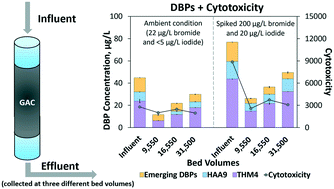Treating water containing elevated bromide and iodide levels with granular activated carbon and free chlorine: impacts on disinfection byproduct formation and calculated toxicity†
Abstract
We evaluated the efficacy of granular activated carbon (GAC) adsorption for mitigating formation of chlorine disinfection byproducts (DBPs) in water with a wide range of bromide (20–1000 μg L−1) and iodide (<5–100 μg L−1) concentrations. GAC effectiveness was assessed by determining speciated total organic halogen (TOX), 70 DBPs, and calculated cyto- and genotoxicity. Overall, GAC treatment effectively lowered formation of TOX and the majority of targeted DBPs over the evaluated service time (>30 000 bed volumes). In the GAC influent, total organic bromine increased from 10 to 84% of TOX as bromide levels increased from 20 to 1000 μg L−1. Dissolved organic carbon (DOC) removal by GAC increased the bromide-to-DOC (Br/DOC) concentration ratio in GAC effluent relative to influent. As a result, bromine incorporation into DBPs increased after GAC treatment, especially at early GAC service times and low bromide levels. Total organic iodine was <3.5% of TOX, and iodo-DBP formation was low because elevated iodide was only evaluated in the presence of high bromide and free chlorine, a scenario that favors iodate formation. Although trihalomethanes (THMs) and haloacetic acids (HAAs) consistently formed at the highest molar concentrations, they were not major contributors to calculated cyto- and genotoxicity. Principal contributors to calculated cytotoxicity included haloacetaldehydes (HALs), haloacetamides (HAMs), and haloacetonitriles (HANs), while the main drivers of genotoxicity were HALs, HAMs, HANs, and halonitromethanes (HNMs) despite lower concentrations. Because bromine incorporation into DBPs increased nonlinearly with increasing Br/DOC concentration ratios, GAC more effectively controlled calculated toxicity at elevated bromide levels. Calculated cyto- and genotoxicity did not vary strongly with GAC service life, suggesting that GAC treatment can effectively lower calculated toxicity over long periods of operation. The majority of TOX remained unknown (>50%) in all samples despite the quantification of 70 DBPs targeted in this study, highlighting the need to assess toxicity associated with unknown DBPs.

- This article is part of the themed collection: Drinking water oxidation and disinfection processes


 Please wait while we load your content...
Please wait while we load your content...